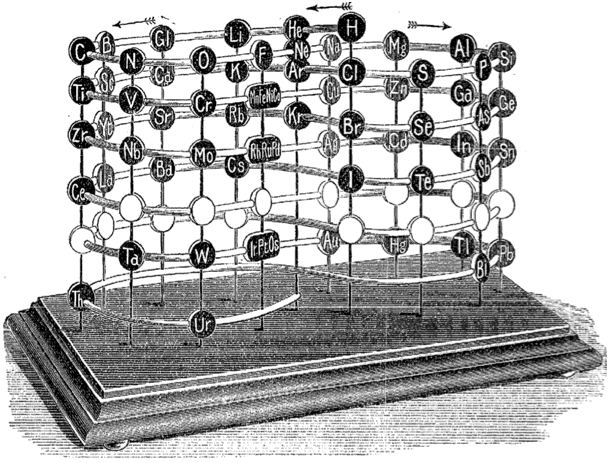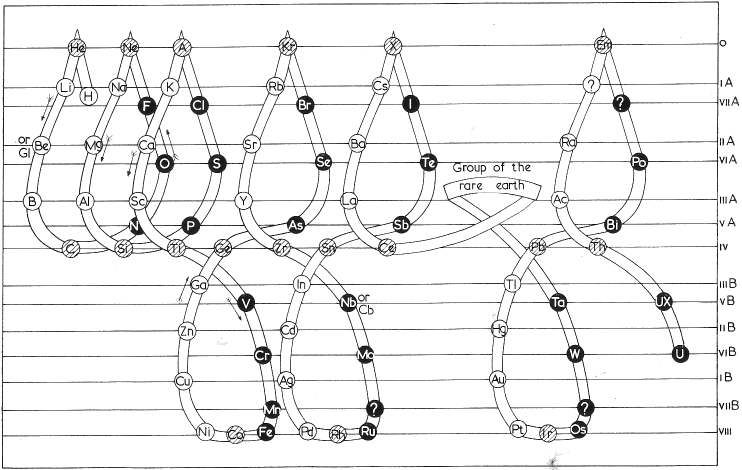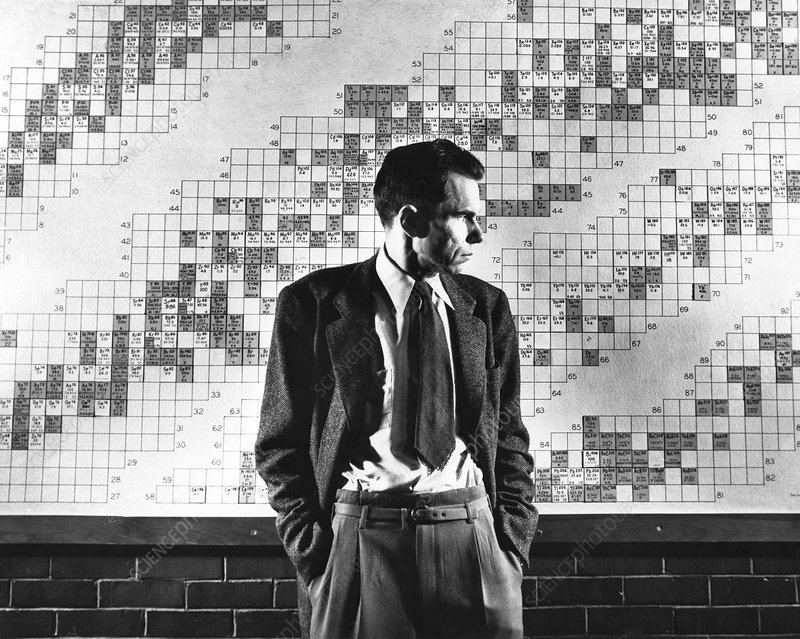
1898 vis generatrix of William Crookes 1832 – 1919
Elements ordered by atomic weigths; similar elements appear underneath each other; missing elements are represented by a white circle. Original model at London Science museum, citato verso la fine dell'articolo.
Crookes added the newly-discovered noble gases (helium, neon, argon, krypton, xenon, radon) to his system, which helped persuade Mendeleev that his table could be adapted to accommodate them.
But more interestingly, Crookes’ periodic system "vis generatrix" illustrated his theory of the evolution of the elements: elements formed in a plasma (a hot state of matter) inside stars. As temperatures cooled, they evolved from the lightest element, hydrogen, at the top of his spiral, to the heaviest, uranium, at the bottom. Crookes' original model physically embodies one of the first evolutionary theories of the elements.
wp/William_Crookes 1832 – 1919. British chemist and physicist, spectroscopist, invented the Crookes tube in 1875 so investigating cathode rays. This was a foundational discovery that eventually changed the whole of chemistry and physics.
1911 Three-Dimensional Periodic System of Frederick_Soddy 1877 – 1956.
Soddy called it "helical representation of the periodic law": lettere nero su bianco sopra il piano del foglio, bianco su nero sotto il piano, le altre nel piano. ref: >>>
wp/Frederick_Soddy 1877 – 1956. English radiochemist.
1903 with Rutherford publish "Law of Radioactive Change": radioactivity involve the spontaneous disintegration of atoms into other (transmutation of elements).
1903 with Sir William Ramsay at University College London: decay of radium produce helium gas.
1921 Nobel Prize in chemistry: research in radioactive decay, formulation of the theory of isotopes.
1960 periodic_table of Otto_Theodor_Benfey
1975 periodic_table of James_Franklin_Hyde 1903 – 1999. American chemist and inventor, “Father of Silicones”, launched the silicone industry in the 1930s, and a method of making fused silica, a high-quality glass later used in aeronautics, advanced telecommunications, and computer chips.
|
what physicists really like, though, is this monster the chart of all radionuclides. |
1946 table_of_nuclides of Glenn_Theodore_Seaborg 1912 – 1999
in front of a chart showing isotopes of various elements in 1946. Credits: sciencephoto.
Seaborg discovered the transuranic element plutonium (Pu) in 1940, and 10 in total. In 1944, Seaborg formulated the Actinide concept which predicted their properties, and the arrangement of the actinide series in the periodic table of the elements.
For this work, he was awarded a share of the 1951 Nobel Prize in Chemistry.
Glenn Seaborg's work with the actinides resulted in the periodic table as we know il today.
credits: wp/File:Isotopes_and_half-life.svg
wp/Table_of_nuclides | wp/Island of stability
Where Your Elements Came From (NASA Astronomy Picture of the Day)
Wikipedia e' veramente una risorsa inestimabile
Los
Alamos National Laboratory's Chemistry Division Presents
Periodic Table of the Elements, A Resource for Elementary, Middle School,
and High School Students



Ora per caso ne ho saputo leggendo-guardando
chemistryworld/the-art-of-the-periodic-table
La 1a volta che si accede al sito, la lettura e' libera, altrimenti e'
richiesta registrazione gratuita.
Per riaccedere io ho provato con una "finestra privata" e mi e' andata
bene.
it: tavola periodica degli elementi